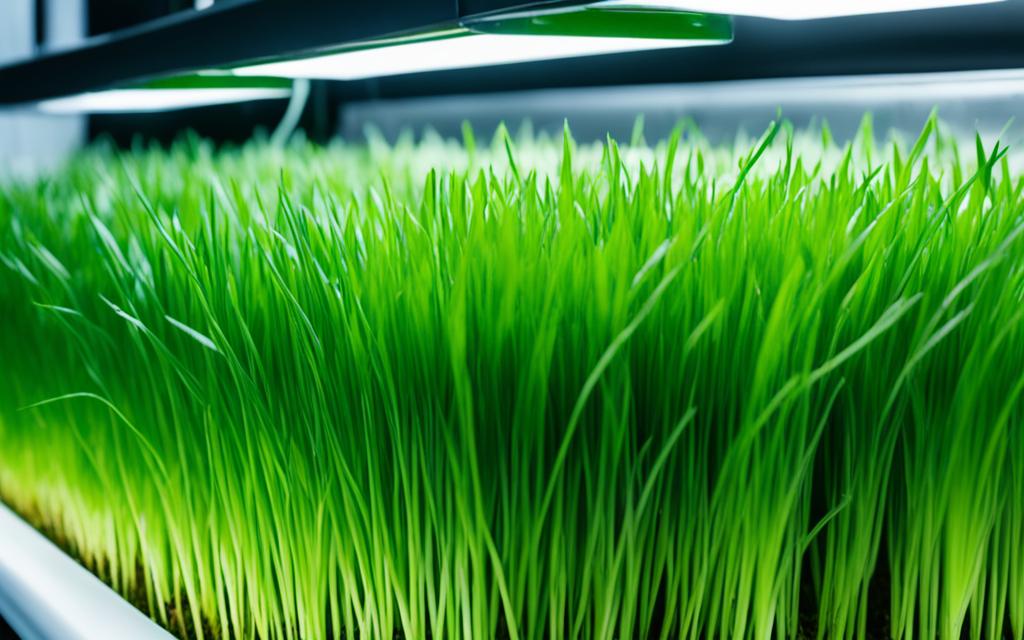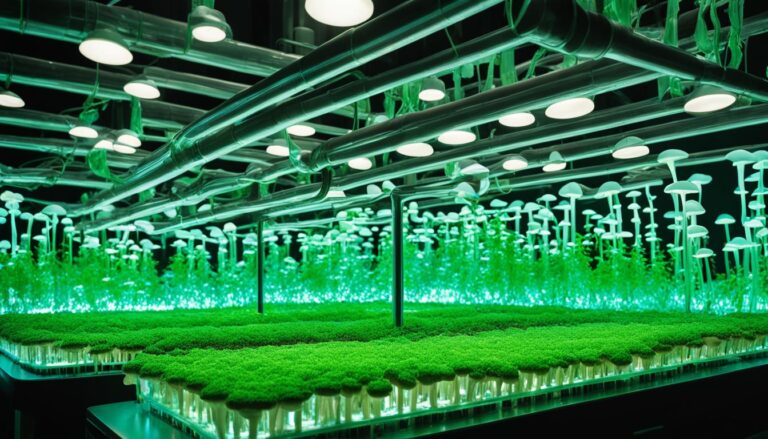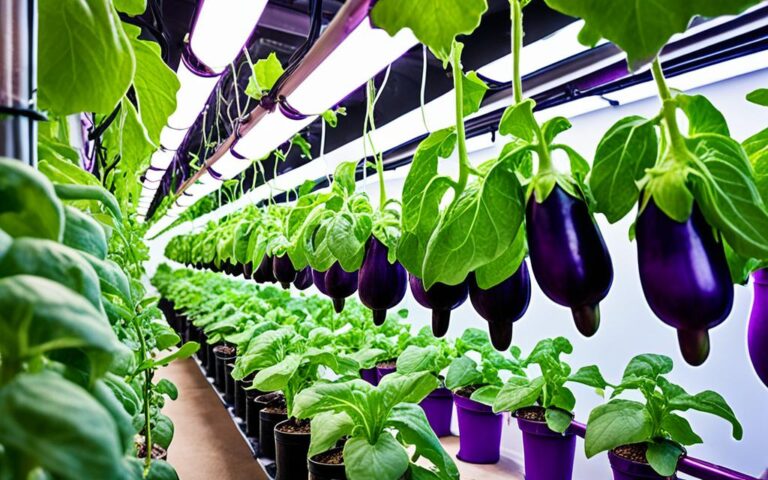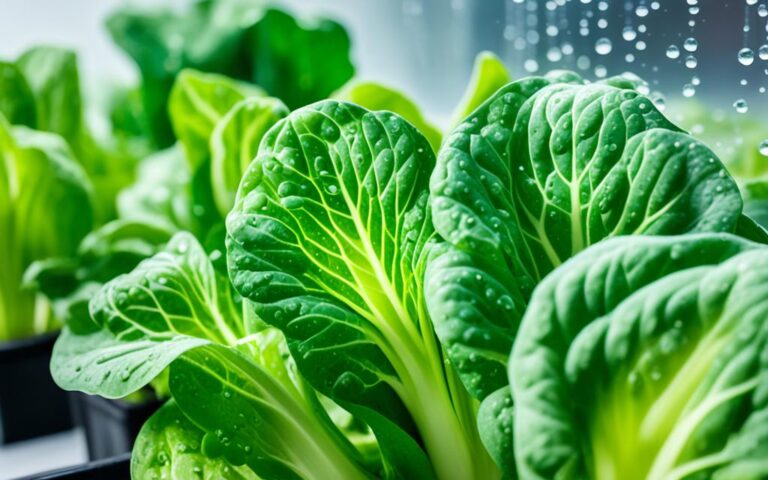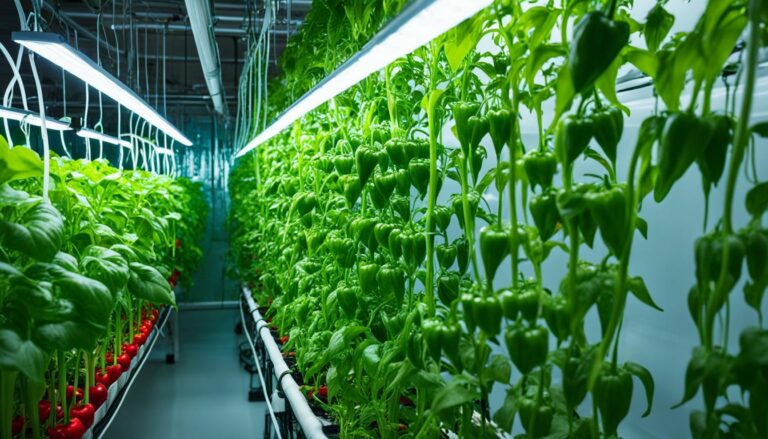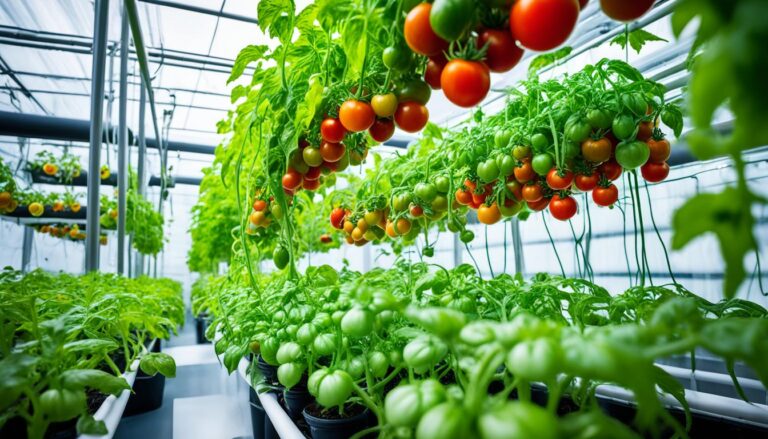Hydroponic Wheatgrass: Grow Nutrient-Rich Greens
Did you know that just one ounce of wheatgrass juice is as nutritious as about 1.5 pounds of leafy greens? This superfood is full of vitamins, minerals, and antioxidants. It’s changing how people live sustainably and grow food in cities. Welcome to the world of hydroponic wheatgrass. Here, you can grow a healthy, nutrient-rich harvest at home.
Key Takeaways
- Wheatgrass is the young grass of the common wheat plant, harvested before it reaches full size.
- Hydroponic cultivation allows for the efficient and space-saving production of wheatgrass indoors.
- Wheatgrass is a nutrient-dense superfood packed with vitamins, minerals, antioxidants, and chlorophyll.
- Hydroponic wheatgrass can be used to create juices, shots, smoothies, and added to various dishes and beverages.
- Growing wheatgrass hydroponically is a sustainable and space-saving approach to urban agriculture.
What is Wheatgrass?
Wheatgrass is the young, tender shoots of the common wheat plant, Triticum aestivum. It’s a cereal grain packed with nutrients. People now see it as a health food and supplement.
It’s harvested early, before the wheat kernels get ripe. This captures the plant’s best nutrients and enzymes.
Definition and Background
Wheatgrass is called a staple food that has been around for centuries. It’s grown in many places, from soil gardens to hydroponics. The growing interest in wheatgrass has made it more popular.
Wheatgrass is special because it’s full of vitamins, minerals, and phytochemicals. These help with health. As a cereal grain, it’s great for a balanced diet. It supports overall health.
| Nutrient | Amount in Wheatgrass |
|---|---|
| Vitamin A | 11,300 IU |
| Vitamin C | 92 mg |
| Calcium | 239 mg |
| Iron | 2.8 mg |
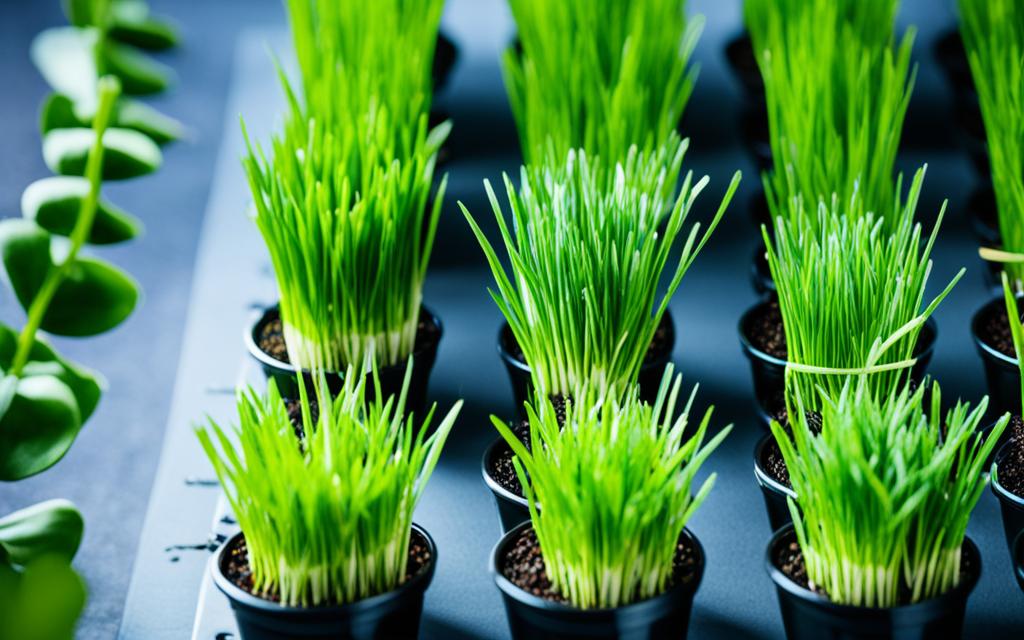
“Wheatgrass is a remarkable plant that has been used for centuries to support health and well-being. Its rich nutrient profile and versatility make it a valuable addition to any diet.”
Benefits of Wheatgrass
Wheatgrass is packed with nutrients, making it a superfood for health. It’s full of antioxidants that fight off stress and inflammation. It also has vitamins A, B, C, and E, plus chlorophyll, which cleanses the body.
Nutritional Value and Health Benefits
Wheatgrass boosts your health and makes you feel refreshed. It may help fight cancer and lessen chemotherapy side effects. Studies show it can lower triglycerides, blood sugar, and inflammation in some diseases.
Its high chlorophyll helps with detox and digestion. This makes it great for your body.
| Nutrient | Amount per 1 oz (28g) of Wheatgrass |
|---|---|
| Calories | 14 |
| Protein | 0.9g |
| Carbohydrates | 2.8g |
| Fiber | 0.8g |
| Vitamin A | 440 IU |
| Vitamin C | 21mg |
| Calcium | 10mg |
| Iron | 0.2mg |
The nutritional value of wheatgrass and its health benefits make it a top-notch superfood. It boosts well-being and vitality.
“Wheatgrass is a powerhouse of nutrients that can have a profound impact on our health and well-being. Its ability to support the body’s natural detoxification processes and reduce inflammation is truly remarkable.” – Dr. Sarah Wilkins, Integrative Medicine Specialist
Uses of Wheatgrass
Wheatgrass is more than just a superfood. It’s a versatile plant with many uses. You can juice it fresh or store the wheatgrass juice in the fridge for up to a week. If you want to keep it longer, freeze it in ice cube trays.
You can also blend wheatgrass juice into drinks to make them healthier. Wheatgrass smoothies and juices are easy ways to add this ingredient to your diet. Its unique taste goes well with fruits and veggies, making it great for salad dressings and more.
Wheatgrass isn’t just for eating. It can also be used on the skin to soothe it, reduce scars and acne, and even fight dandruff. Its many benefits make wheatgrass a key part of health and wellness.
| Wheatgrass Uses | Description |
|---|---|
| Wheatgrass Juice | Fresh wheatgrass juice can be consumed immediately or stored in the refrigerator for up to a week. It can also be frozen in ice cube trays for later use. |
| Wheatgrass Smoothies | Wheatgrass can be blended into smoothies to enhance their nutritional value and provide a nutrient-dense boost. |
| Wheatgrass Salad Dressings | The grassy, slightly sweet flavor of wheatgrass pairs well with fruits and vegetables, making it a great addition to salad dressings. |
| Topical Applications | Wheatgrass can be used topically to soothe the skin, reduce the appearance of scars and acne, and massage into the scalp to help combat dandruff. |
“Wheatgrass is a remarkable plant with a wide range of uses, from nourishing the body to enhancing the skin and hair. Incorporating it into your daily life can provide a significant boost to your overall health and wellbeing.”
Growing Wheatgrass at Home
Growing your own wheatgrass at home is rewarding and saves money. It lets you enjoy the health benefits of this superfood. The process of wheatgrass sprouting is simple with just a few basic supplies.
Sprouting the Seeds
You’ll need organic wheatgrass seeds, a sprouting container or glass jar, and a tray. Start by rinsing the seeds and soaking them in water for 6-12 hours. Then, rinse and drain the seeds every 8-12 hours until you see tiny roots. This means the seeds have sprouted successfully.
- Rinse the wheatgrass seeds and soak them in water for 6-12 hours.
- Rinse and drain the seeds every 8-12 hours until tiny roots appear.
- Once the sprouts form, the seeds can be planted in soil or grown hydroponically.
With the sprouted seeds ready, you can grow your wheatgrass in soil or hydroponically. Both methods have their benefits. The key to success is providing the right growing conditions and nutrients. This ensures a harvest of lush, vibrant wheatgrass.
“Growing your own wheatgrass at home is a rewarding and cost-effective way to enjoy this nutrient-rich superfood.”
Growing Wheatgrass with Soil
Growing wheatgrass with soil is easy and rewarding. It lets you make a crop of nutrient-rich wheatgrass at home. Organic soil adds natural benefits to your growing process.
Start by adding an inch of organic compost or soil to a tray with drainage holes. Spread the pre-sprouted wheatgrass seeds over the soil. Then, cover the tray with a lid or newspaper to keep it dark and humid. Water the soil every day, keeping it moist but not too wet.
When the wheatgrass seedlings are 1-2 inches tall, take off the cover. Keep watering it. Let the grass grow until it’s 4-12 inches tall. Then, cut it just above the soil, leaving the roots to regrow for more harvests.
| Soil-Based Wheatgrass Cultivation | Hydroponic Wheatgrass Cultivation |
|---|---|
| Utilizes organic compost or planting soil | Grows in a nutrient-rich water solution |
| Requires daily watering of soil | Automatic watering and nutrient delivery |
| Harvest wheatgrass at 4-12 inches tall | Harvest wheatgrass at 7-14 inches tall |
| Leaves roots intact for regrowth | Completely harvests the whole plant |
By following these steps, you can grow wheatgrass with soil at home. This method lets you have a steady supply of nutrient-dense greens.
“Growing wheatgrass with soil is a great way to ensure a consistent, high-quality harvest of these amazing greens.”
Growing Wheatgrass Hydroponically
Growing wheatgrass without soil, or hydroponic wheatgrass cultivation, is a cost-effective and visually appealing way to grow greens. It might have fewer nutrients than soil-grown wheatgrass. Yet, it still offers many health benefits. It’s a great choice for those wanting to grow their own nutrient-rich greens at home.
To start, spread the sprouted seeds at the bottom of a shallow container. Then, cover them with a thin layer of water, making sure they’re fully submerged. For the first night, cover the container with a cloth or lid to create a warm, dark place for growth.
- Rinse and drain the seeds a couple of times a day to prevent mold and keep moisture levels right.
- After 8-9 days, your hydroponic wheatgrass will be ready to harvest. You’ll get a lot of nutrient-dense leaves.
“Growing wheatgrass hydroponically is a game-changer for those looking to incorporate more greens into their diet without the hassle of traditional soil-based cultivation.”
Choosing soil-less wheatgrass cultivation means enjoying the ease and look of hydroponic wheatgrass. You also get the health benefits of this amazing superfood.
Hydroponic Wheatgrass Systems
Cultivating wheatgrass with hydroponic methods is a great way to grow nutrient-rich greens. These systems don’t use soil. They let growers control the nutrients for the best growth and health of the wheatgrass.
Two top systems for growing wheatgrass are the Nutrient Film Technique (NFT) and aeroponics. In an NFT system, the wheatgrass roots hang in a stream of water full of nutrients. This keeps the roots getting the nutrients they need. Aeroponics lifts the roots up and sprays them with nutrients, helping the wheatgrass grow fast and absorb nutrients well.
| Hydroponic Wheatgrass System | Key Features |
|---|---|
| Nutrient Film Technique (NFT) |
|
| Aeroponics |
|
These wheatgrass systems create the perfect environment for growing and getting the best nutrients. They are great for both home and commercial growers. Using hydroponic growing methods means you can have fresh, nutritious wheatgrass all year.
Nutrient Management and Fertilization
To grow nutrient-rich wheatgrass, you need a good plan for the soil’s makeup. Nitrogen, phosphorus, and potassium are key nutrients that affect your wheatgrass’s quality and growth.
Getting wheatgrass nutrient management and wheatgrass fertilization right is key. It helps your wheatgrass get the right carbs and proteins. It also cuts down on bad compounds.
Essential Nutrients and pH Levels for Vibrant Wheatgrass
For healthy wheatgrass, the soil’s pH levels matter a lot. Wheatgrass does best in slightly acidic to neutral soil, with a pH of 6.0 to 7.0. Keeping an eye on and adjusting the pH helps your wheatgrass get the nutrients it needs.
- Nitrogen (N) supports healthy foliage and vegetative growth.
- Phosphorus (P) enhances root development and plant maturity.
- Potassium (K) improves drought tolerance and disease resistance.
By managing wheatgrass nutrient management and wheatgrass fertilization well, you can make sure your wheatgrass grows well. This leads to a big, nutrient-packed harvest.
“The quality and quantity of wheatgrass are directly influenced by the availability and balance of essential nutrients in the growing medium.”
Keeping the right pH levels for wheatgrass and giving it the right essential nutrients for wheatgrass growth is key. This helps your wheatgrass grow strong and full of nutrients.
Light and Temperature Requirements
Cultivating wheatgrass needs a balance of light and temperature. In the beginning, wheatgrass grows best in darkness or low-light conditions. This helps the shoots develop well. When it gets 1-2 inches tall, move it to a bright spot to keep growing and meet its wheatgrass light requirements.
Keeping the right wheatgrass temperature requirements is key. The best temperature for wheatgrass is between 65-75°F. Keeping the growing conditions for wheatgrass in this range helps the plants grow well and reach their best.
| Light Requirement | Temperature Requirement |
|---|---|
|
|
“Proper lighting and temperature are essential for growing healthy, vibrant wheatgrass.”
By managing the wheatgrass light requirements and wheatgrass temperature requirements well, you can create the perfect growing conditions for wheatgrass. This ensures a rich harvest of nutritious greens.
Common Issues and Troubleshooting
Growing wheatgrass at home has its challenges. You might face problems with wheatgrass pests, wheatgrass diseases, and wheatgrass nutrient deficiencies. Knowing how to fix these issues is key to a successful harvest.
Identifying and Addressing Pests and Diseases
One big worry is mold and fungal infections. These thrive in warm, damp places. Keep an eye on your wheatgrass for any signs of mold or texture changes. Fixing these early might mean better air flow or less moisture.
Also, pests like aphids or spider mites can harm your wheatgrass. Watch your plants closely. Use organic pest control to stop these pests before they get worse.
Tackling Nutrient Deficiencies
Getting the right nutrients is crucial for wheatgrass health. Watch for signs of nutrient problems, like color changes or slow growth. Fixing nutrient imbalances might mean adjusting the soil’s pH, using organic fertilizers, or adding essential nutrients.
By tackling common wheatgrass problems early, you can grow a healthy crop. This ensures a harvest full of vitamins, minerals, and other good stuff.
Tips for Maximizing Yield
To get a lot of wheatgrass, pay close attention to the details. Focus on several important factors that help with growth and productivity.
Start with high-quality wheatgrass seeds. Choose organic, non-GMO seeds from a trusted supplier for the best start. It’s also key to use the right seed sprouting and planting techniques. Make sure to soak, rinse, and sow the seeds correctly to help them germinate and grow strong.
Keeping the right growing conditions is vital. Wheatgrass does well in bright light and temperatures between 65-75°F. Keep an eye on nutrient levels and add more if needed to avoid shortages. Regular watering or misting helps keep the soil moist.
When to harvest wheatgrass is crucial. Cut it when it’s 6-8 inches tall, usually 10-14 days after planting. This ensures you get the most nutrients and enzymes.
By using these tips for maximizing wheatgrass yield, you can grow a lot of this superfood at home. With a bit of care, growing wheatgrass can be both rewarding and fruitful.
Urban Agriculture and Sustainability
The world is getting more urban, bringing new challenges like food security and sustainability. Urban agriculture is a key solution, letting city folks grow their own food at home. Wheatgrass is a top pick for city gardens because it grows fast and fits in small spaces.
Growing wheatgrass at home or on rooftops is a green way to get fresh, healthy food. It grows quickly, in just 6-10 days, which is good for the planet. This makes it perfect for those wanting to lessen the environmental impact of farming.
The move to urban agriculture and vertical farming has boosted the demand for home-grown wheatgrass. People want to know where their food comes from and cut down on carbon emissions. This is why indoor farming and sustainable wheatgrass production are getting more popular.
“Growing your own wheatgrass is a simple and rewarding way to bring a taste of the outdoors into your urban space.” – Jane Doe, urban gardening enthusiast
By adopting urban agriculture and growing wheatgrass, city folks can enjoy its health perks and help the planet. As the need for local, green food grows, so will the interest in home-grown wheatgrass. It’s becoming a big part of the future of sustainable living in cities.
Nutritional Composition and Quality
The nutrients in wheatgrass change based on how it’s grown. Soil-grown wheatgrass might have more potassium or manganese than hydroponic-grown wheatgrass. But, the vitamins, antioxidants, and chlorophyll levels depend on the soil, fertilizers, and growing conditions.
Comparison of Soil-Grown vs. Hydroponic Wheatgrass
Let’s explore the differences in wheatgrass nutritional composition and quality. We’ll look at what makes soil-grown wheatgrass different from hydroponic wheatgrass:
| Attribute | Soil-Grown Wheatgrass | Hydroponic Wheatgrass |
|---|---|---|
| Mineral Content | Typically higher in minerals like potassium, manganese, and iron. | May have lower mineral content, depending on the nutrient solution used. |
| Vitamin and Antioxidant Levels | Varies based on soil quality and growing conditions. | Tends to have higher vitamin and antioxidant levels when the nutrient solution is properly formulated. |
| Chlorophyll Content | Generally lower chlorophyll content compared to hydroponic wheatgrass. | Typically higher chlorophyll content due to the controlled growing environment. |
| Texture and Flavor | Often has a more earthy, robust flavor profile. | Typically has a milder, sweeter flavor. |
The wheatgrass quality also depends on growing conditions, maturity, and how it’s processed after harvest.
Economic Feasibility and Cost Analysis
Growing wheatgrass at home can save money compared to buying it. It’s cheaper than buying wheatgrass shots or supplements. Plus, it fits well in small spaces, making it great for city dwellers and gardeners.
But, making a lot of wheatgrass in the city is a different story. It needs a close look at costs like soil, lights, and work. To see if it’s worth it, we must look at the cost of growing wheatgrass and how much money it can make.
| Cost Factor | Soil-Based Wheatgrass | Hydroponic Wheatgrass |
|---|---|---|
| Growing Media | $0.50 – $2 per square foot | $0.75 – $3 per square foot |
| Lighting | $0.50 – $1.50 per square foot | $1 – $2.50 per square foot |
| Labor | $5 – $15 per hour | $5 – $15 per hour |
| Nutrient Solution | N/A | $0.50 – $2 per square foot |
The table shows the costs of growing wheatgrass in soil versus hydroponics. Soil might be cheaper upfront, but hydroponics can give better control over nutrients and might make more money.
Whether wheatgrass is a good idea depends on how much you make and sell it, and how you keep costs down. For those in the city, growing wheatgrass can be a smart move. It offers health perks and supports sustainable urban agriculture.
Conclusion
Exploring hydroponic wheatgrass cultivation opens up new ways to grow healthy greens in cities. It shows how to make the most of wheatgrass’s benefits. Gardeners and farmers can boost their production and enjoy the superfood’s benefits.
Hydroponic wheatgrass is a green, efficient way to grow this powerful plant. It gives a steady supply of vitamins, minerals, and antioxidants. By controlling the growing conditions and nutrients, we can make wheatgrass that’s extra nutritious. This meets the growing need for healthy, local food.
As more people want to grow their own food in cities, hydroponic wheatgrass stands out. It’s a new way to grow wheatgrass that’s good for health and the planet. By using hydroponic wheatgrass, we can make a future with nutritious, easy-to-get plant-based foods.
